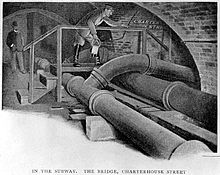Thames Water
| Thames Water | |
|---|---|
| legal form | Limited |
| founding | 1989 |
| Seat |
Reading , UK |
| Branch | Water supply company |
| Website | www.thameswater.co.uk |
Thames Water is a private UK water company . The company had been a subsidiary of the German energy group RWE since 2001 . Following a sale announcement in January 2006, the company has been owned by Kemble Water , a consortium led by an Australian investment fund, since October 2006 . It supplies 8.7 million customers in the Greater London area and the surrounding regions with drinking water and operates sewage disposal.
Thames Water was founded in 1989 under the direction of the neoliberal British Prime Minister Margaret Thatcher from the state water authority Thames Water Authority, founded in 1973 as Thames Water Utilities Limited (comparable to a stock corporation). With the establishment of the company, the aim was to mobilize private capital for the rehabilitation of the decaying London water and sewage system.
The line system
The supply system consists of 32,000 km of drinking water pipes and 108,000 km of sewage pipes . The London part is the oldest network in a large city and the damage to the lines is correspondingly large. According to estimates, more than 30 percent of the drinking water seeped from the pipes into the ground in May 2006 and the water pressure in the pipes fluctuates constantly. The water becomes stale as a result of air entering the pipes.
The losses in the water supply system are offset by additional water reservoirs on the lower reaches of the Thames. These obtain the drinking water from filter wells in the heavily polluted Thames water . Around 50 times a year, overloaded canals mean that untreated sewage has to be discharged directly into the Thames, which contributes to the pollution of the bank wells.
The London sewers date from the 19th century and were built with bricks. Due to the intense traffic in the metropolis, they are subject to constant vibrations that accelerate their decline. Time and again wastewater accumulates in broken channels and leaks to the surface. This made Thames Water the English company most frequently prosecuted for environmental crimes.
The enterprise
The main shareholders were US pension funds and London banks. Like other privatized state-owned companies, Thames Water had been exempt from all profit taxes. The profit expectations of the capital owners and the management were soon met with double-digit returns and increases in salaries for the managers. However, water prices also rose while there was no investment in the outdated pipeline network.
In the 1990s, the water business appeared as "blue gold" to international investors and utility companies. RWE intended to stand up to its French competitors Vivendi / Veolia and Suez / Ondeo on the world market. In 1999, Thames Water, with its 8 million water customers and 15 million wastewater customers, offered itself as the basis for entering the water business . In addition, it brought in its ties in the British Commonwealth which were greatly beneficial for expansion in Asia, Australia, Africa, the United States, Canada and South America. The most expensive acquisition here was American Water Works Company - the largest US water company - at € 8 billion . At the beginning of 2006 the company had a total of around 70 million customers worldwide.
RWE's profit calculations were thwarted due to ongoing protests in the London population. First of all, the Mayor of London Ken Livingstone made himself the consumer advocate. He advised his fellow citizens: “Do not use the toilet flush after urinating! Save the water for your tea. ”Finally, the regulatory authority Ofwat ( Office of Water Services ) stepped in and demanded from RWE € 714 million in investments for the drinking water pipes and € 470 million in the sewers, which were made in the period between 2005 and 2010 are to be provided. This is intended to reduce the daily water loss from 915 million liters to 725 million liters. Thames Water was forbidden to allocate the investments to the water prices and to show an annual return of more than six percent. Nevertheless, RWE managed to increase its operating profit in 2005 by two percent to € 1.4 billion.
Sold to Kemble Water
Following a bidding process , RWE announced that it would sell Thames Water to the consortium Kemble Water for £ 4.8bn after approval by the antitrust authorities . Terra Firma Capital Partners and a consortium made up of the Swiss investment bank UBS and Qatar participated in the bidding process . Kemble Water also took on Thames Water's £ 3.2 billion debt. Kemble Waters is backed by a consortium with Australia's Macquarie Bank .
Web links
swell
- ↑ BBC News, June 22, 2006: Thames Water misses leak target
- ↑ RWE sells Thames Water - Sanus per aquam. In: n-tv. October 17, 2006, accessed October 22, 2006 .
- ↑ RWE fills the war chest - Thames Water sold. In: n-tv. October 17, 2006, accessed October 22, 2006 .

